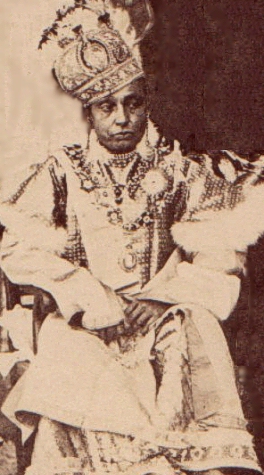Sikandar Begum facts for kids
Quick facts for kids Sikandar Begum |
|
|---|---|
| Her Highness Nawab Sikander Begum Sahiba, Nawab Begum of Dar ul-Iqbal-i-Bhopal, GCSI | |
 |
|
| Nawab of Bhopal | |
| Reign | 30 September 1860 – 30 October 1868 |
| Predecessor | Jahangir Mohammad Khan |
| Successor | Shah Jahan Begum |
| Born | Sikandar Begum 10 September 1817 Gauhar Mahal, Bhopal State, British India (present-day Madhya Pradesh, India) |
| Died | 30 October 1868 (aged 51) Moti Mahal, Bhopal State, British India (present-day Madhya Pradesh, India) |
| Burial | Farhat Afza Bagh, Bhopal |
| spouse | Jahangir Mohammad Khan |
| Issue | Shah Jahan Begum |
| Father | Nasir Mohammad Khan |
| Mother | Qudsia Begum |
| Religion | Islam |
Sikandar Begum (born September 10, 1817 – died October 30, 1868) was a powerful female ruler. She was the Nawab of Bhopal, a state in India. She ruled from 1860 until her death in 1868.
Sikandar Begum first became a regent (a temporary ruler) for her young daughter in 1844. By 1860, she was officially recognized as the Nawab. During the 1857 Sepoy Mutiny, she supported the British. This earned her a special award, the Knight Grand Commander. In 1863, she became the first Indian ruler to complete the Hajj, a pilgrimage to Mecca. Sikandar Begum made many important changes in her state. She created a new system for money, a government office called a secretariat, a type of parliament, and a modern court system.
Contents
Early Life and Family
Sikandar Begum was born on September 10, 1817. Her birthplace was Gauhar Mahal in Bhopal State, which was part of British India. Her parents, Nasir Muhammad Khan and Qudsia Begum, had also been rulers of Bhopal.
On April 18, 1835, Sikandar married Nawab Jahangir Mohammad Khan. They had one daughter together, named Shah Jahan Begum.
Becoming a Ruler
On January 3, 1847, Sikandar Begum's daughter, Shah Jahan Begum, became the ruler of Bhopal. She was only nine years old at the time. So, on July 27, 1847, Sikandar Begum was named the regent. This meant she would rule the state until her daughter was old enough. The British Governor-General gave her full power to manage the state.
Supporting the British
During the 1857 Sepoy Mutiny, Sikandar Begum chose to support the British. She took steps to prevent any rebellion in Bhopal. She stopped people from printing anti-British writings. She also improved her spy network and paid soldiers to switch sides.
However, some soldiers attacked British camps in August. This made many people in Bhopal angry with her. In December, these soldiers, encouraged by Sikandar's mother, surrounded her palace. Sikandar sent her son-in-law to talk with them. The soldiers ended their protest when she promised to increase their pay. In 1861, she received the Knight Grand Commander award. This was for her strong support of the British during the mutiny. The British officially recognized her as the Nawab of Bhopal on September 30, 1860. Her military salute was also increased the next year.
Journey to Mecca
In 1863, Sikandar Begum made history. She became the first Indian ruler to perform the Hajj. This is a special religious journey to Mecca. About 1,000 people, mostly women, traveled with her.
Sikandar wrote a book about her trip in Urdu. An English version was published later in 1870. In her book, she described some cities as "unclean." She also wrote that some people she met were "uncivilised." Her memoir also tells a story about her argument with Turkish customs officials. They wanted to charge taxes on everything she brought with her.
Important Changes and Improvements
Sikandar Begum made many important changes to her state. She divided Bhopal into three main areas and 21 smaller ones. She appointed a special officer for each area to manage money and an administrator for each smaller area. She also managed to pay off a large debt that the state had.
She set up a customs office to collect taxes on goods. She created a secretariat, which is a main government office. She also built an intelligence network to gather information. Sikandar Begum established a mint to make coins. She also started a postal service that connected Bhopal with the rest of India. She created a modern court system, including a special court of appeal.
Education and Government
Sikandar Begum cared about education. She founded the Victoria School for girls. She also made sure there was at least one middle school in each district. These schools taught in Urdu and Hindi.
In 1847, she introduced a Majlis-e-Shoora, which was like a parliament. This group included important people and thinkers. Their job was to suggest and approve new laws and ideas for improvements. In 1862, she changed the official court language from Persian to Urdu.
Buildings and Personal Life
Sikandar Begum had several beautiful buildings constructed. She built a Moti Masjid (a mosque) using red sandstone. She also built two palaces, the Moti Mahal and the Shaukat Mahal. The Shaukat Mahal combined European and Indo-Islamic architecture styles. It even had some Gothic features.
Sikandar Begum was a very religious Muslim, like her mother. However, she did not wear the niqab (a face veil) or practice purdah (female seclusion). She was a very active and brave person. She enjoyed hunting tigers and playing polo. She was also skilled in swordsmanship, archery, and lancing. Sikandar Begum personally led her army. She also regularly checked on courts, government offices, the mint, and the treasury.
Sikandar Begum passed away on October 30, 1868, due to kidney failure. She was buried at Farhat Afza Bagh. Her daughter, Shah Jahan Begum, became the next Nawab of Bhopal.

